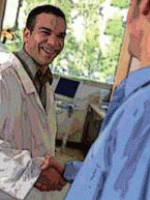Multidisciplinary Training
As indicated in the first chapter, science is becoming increasingly multidisciplinary. Thus, mentees may need to receive training in different fields of science to accomplish their goals. Multidisciplinary training is more essential than ever, and having a mentor whose skills and outlook are complementary is recommended. Mentors should consider whether to encourage their mentees to receive training in additional disciplines depending on the individual situation. Additionally, mentors should be prepared to support this training, to help find and recruit other mentors if appropriate, and to assist mentees in developing a plan to work with others outside the mentors' own fields.
Networking Within and Across Disciplines

Many scientists are focused on collaborators in their own division, department, or field. However, networking across divisions, departments, and institutions is an important way to identify potential collaborators who might be willing to share data and other resources (Saha et al., 1999). It is also a way to adopt a more multidisciplinary perspective. Building a professional network is crucial to successful academic careers (Bland and Ruffin, 1990; Bower et al., 1999). A mentor should help mentees build their own network of contacts and potential collaborators. Most researchers are willing to talk about their work and exchange ideas with junior colleagues or fellows. For junior faculty or fellows who are new to an institution, several recommendations for networking techniques are provided on the next page. Many organizations also have formal one-on-one mentoring programs and networking events at their meetings.
Mentoring Mosaic
A mentoring mosaic is typically constructed such that a mentee works with mentors in separate but complementary ways. Members of the mentoring mosaic may work with the mentee in different roles, such as a "research mentor" and a "career mentor," or they may mentor on different aspects of a research project. There are many reasons to develop a mentoring mosaic: for example, the available mentors may not meet all mentee needs, or either a mentee desires or the science demands a more multidisciplinary experience. It is common to find a senior methodological mentor, but one who lacks content knowledge in a chosen field (or vice versa). A primary mentor can help develop this mosaic.
The mentoring mosaic can include multiple senior level mentors or a combination of senior mentors and peer mentors. Peer mentors are colleagues at the mentee level or slightly above who provide advice and counsel (Chin et al., 1998). Types of peer mentors include basic peer mentors, facilitator mentors, and peer mentor project managers. A basic peer mentor is a self-identified junior faculty member with shared interest; a facilitator mentor is a faculty member with expressed interest and skill in mentoring; and a peer mentor project manager is a member of the peer group identified as lead author or manager of an academic project. Data indicate that semistructured, facilitated group mentoring improved writing, satisfaction with accomplishments, and skills needed for success.
Networking Techniques
- Begin with senior colleagues who have a long tenure at the institution. Ask them for names of colleagues who share your interests.
- Invite a potential colleague for coffee or lunch, share your interests, and learn his/hers. Explore fruitful areas for collaboration. Ask for other names of colleagues who might have a substantive or methodological interest related to yours.
- For epidemiologists and health services researchers: In addition to the usual medicine and public health departments, it is common to find like-minded people working in departments of anthropology, medicine, sociology, economics, psychology, political science, and public policy.
- Look beyond your institution. Find out who the experts are in your area of interest and contact them. Take advantage of national meetings to set up lunch or coffee with these individuals.
- Productive fellows rarely work alone. Find ways to broaden your circle. Your fellowship program director should provide you with names of people to contact.
Recruitment of Underrepresented Scholars
The drug abuse research community has traditionally placed a high priority on recruiting minority trainees from diverse and uderrepresented backgrounds, including racial and ethnic minorities. This priority has been a part of all facets of the research mentoring process and is consistent with NIH's commitment to increasing the pool of investigators from underrepresented minority groups in biomedical and behavioral research. Since 1989, NIH has mandated that all training grant proposals include specific plans to recruit and retain underrepresented minorities. In addition, NIH now requires that training directors document recruitment efforts and minority retention data in all progress reports, and that they provide information on both successful and unsuccessful recruitment strategies. The success of efforts to recruit and retain minority trainees is also a factor in the assessment of the quality of the trainee pool and is reflected in the priority score of the application. If minority recruitment plans are judged to be unacceptable, funding can be delayed or withheld.

Even with these guidelines in place, creative efforts are needed for success. Science recently reported that NIH is increasing its minority employment efforts after missing its recruitment target (Mervis, 2006). NIH is considering a proposal to double its recruitment of minority candidates seeking doctoral degrees in the biomedical and behavioral sciences over the course of 8 years. Other programs to recruit more minorities have not done well: less than 15 percent of undergraduates in the Minority Access to Research Careers U*STAR program progressed to Ph.D. studies. Additionally, nearly 40 percent of those funded for the Minority Opportunities in Research (MORE) Program go on to faculty positions rather than to junior investigator positions.
NIDA has a number of programs to support and further mentor underrepresented scholars, including the Summer Research with NIDA Program; the Diversity Supplement Program; the Diversity-promoting Institutions Drug Abuse Research Program (DIDARP); and the Recruitment and Training Program offered by NIDA's intramural program. In some cases, these programs will support minority students very early in the development of their science skills (high school) as well as those at the Ph.D. or M.D. level. The Diversity Supplement Program supports individuals underrepresented in science to work on currently funded grants through the diversity supplement program. The DIDARP provides funding to institutions to increase the capacity of identified scholars to conduct drug abuse research, fosters the research career development of racial/ethnic minority and other faculty and staff who are underrepresented in drug abuse research, and enhances the research infrastructure of diversity-promoting institutions.
In addition to NIH's efforts to foster improved mentorship and training for underrepresented researchers, a number of other organizations have created programs to identify new opportunities to recruit minority students for careers in research:
- The National Name Exchange Program and the Western Name Exchange Program are consortia comprising 29 universities that annually collect and exchange names of talented, underrepresented, racial and ethnic minority students who are in their junior or senior year of undergraduate education. The purpose of the name exchanges is to ensure that participating universities are aware of and recruit talented and qualified minorities from universities across the country. Each consortium site also conducts other activities consistent with national efforts to increase the enrollment of traditionally underrepresented peoples in graduate education. A good example of collaboration in this arena is the University of Washington's Graduate Opportunities and Minority Achievement Program (GO-MAP), which has maintained and facilitated access to the databases for both of these name exchange programs since the mid-1980s and continues to do so.

- The TRIO Ronald E. McNair Postbaccalaureate Achievement Program encourages low-income, first-generation college students and students underrepresented in graduate education to consider careers in college teaching as well as to prepare for doctoral study. Funded by the U.S. Department of Education, the McNair program provides research opportunities, faculty mentors, support for publishing and presenting research findings, teaching assistantships, and assistance with applications to graduate schools. Each spring, the names, addresses, majors, and areas of interest for graduate study of seniors who will graduate in December and May are collected from McNair directors nationwide. This information is compiled into a database that is distributed to all graduate school deans in the country for use in recruitment.
Other activities for mentors that can increase the diversity of mentees:
- Consider the quality and diversity of the undergraduate population as a potential recruitment pool. Invite students to an open house.
- Use regional and national databases to identify top students who are underrepresented in drug research disciplines. Gather lists of potential mentees who participated in programs such as the McNair Scholars and the Western and National Name Exchange Programs. Obtain lists of potential students interested in relevant programmatic areas and follow up with targeted letters, e-mails, and phone calls.
- Draw on a variety of recruiting mechanisms, including Web sites, targeted mailings, telephone calls, posters, advertisements, and receptions at professional conferences.
- Create a Web site that highlights both mentoring opportunities for trainees and student accomplishments (e.g., publications, awards), as well as provides stories and testimonials about recent experiences. Show the diversity of mentors and mentees on the Web site.
- Advertise programs to targeted populations in colleges and universities that serve a large population of minority and underrepresented students to increase the minority applicant pool.
- Notify undergraduate departments in relevant disciplines, particularly targeting schools with large minority populations. Utilize the Western and National Name Exchange Programs (GO-MAP coordinates the national database) and send direct mailings to historically Black colleges and universities, Hispanic-serving institutions, and tribal colleges.
- Advertise in multicultural journals.
- Ask your own trainees to help in recruiting.
- Lead by example: efforts are aided by having a diverse faculty and training cohort.
Mentees from underrepresented groups need to feel that they are valued members of the research team and not isolated from other research fellows or trainees in their programs. To help build trust, mentees should be encouraged to build mentoring relationships with other underrepresented investigators at other institutions or departments. Mentors should—
- Encourage mentees to meet others with similar backgrounds.
- Encourage collaboration among other mentees.
- Suggest a group of mentees agree to support each other as peer mentors.
- Suggest internships, awards, seminars, or other programs for underrepresented minorities.
- Be supportive of associations for minority trainees and encourage membership.
- Help build mentee confidence.
- Be accessible.
Mentoring in the Responsible Conduct of Research
Since July 1990, NIH has required that all training grants and mentored scientists' (relevant Ks) proposals include plans for instruction in the responsible conduct of research (RCR). According to the funding announcements, applications must include a description of instruction in scientific integrity. Areas that must be covered include—
- conflict of interest;
- responsible authorship;
- policies for handling misconduct;
- data management;
- data sharing; and
- policies regarding the use of human and animal subjects.
Plans must address the topics, as well as the format of the instruction, participation of faculty, a list of required attendees, and the frequency of the program.
Because NIH encourages collaborating institutions—regardless of their source of support—to provide instruction in RCR to all graduate students, postdocs, and research staff, mentors must make RCR training a priority. Ideas for mentoring include arranging for the mentee to observe or serve on a local human subjects committee, institutional review board, or institutional animal care and use committee; to actively participate in discussions on the ethical conduct of science; and to become involved with institutional RCR activities either on the World Wide Web (see Training in the Responsible Conduct of Research for more information) or in person.
It is recommended that this training be ongoing. Ongoing training combined with a substantial plan is the standard expectation of the NIH review committee that reviews these applications for NIDA. Training for the Health Insurance Portability and Accountability Act of 1996 and previous ethics courses in graduate school are not ongoing and are therefore not applicable. The Office of Research Integrity Newsletter includes information about RCR training, misconduct case reports, articles, new regulations, conferences that specifically address RCR, and other important and timely news. Articles from this quarterly newsletter can be discussed with mentees as well.
Mentoring at a Distance
Sometimes a mentee has no choice but to go outside of his/her institution or geographical area to find an appropriate mentor (Bennis, 1994). If the mentor–mentee relationship is long-distance, the following recommendations are provided for improving the mentoring experience:
- Meet your mentor at national meetings for regular in-person meetings.
- If describing this mentoring in a proposal, write and highlight a persuasive argument to convince reviewers that it can work. Ask your mentor to address this issue specifically in the letter of support that is sent with the grant proposal.
- Discuss distance issues with members of NIDA's Training Committee so that they understand the importance of your requested mentor.
- E-mail your mentor at least once per week.
- Plan to visit the mentor for face-to-face meetings and determine how frequent these meetings must be. If describing the plan for meetings in an application, justify the frequency of these meetings. Meet other trainees at the mentor's lab. Communicate with the other trainees often as well, as they will become your cohort. When you are at national meetings, spend time with that cohort of mentees.
- Invite your mentor to your university to give talks and to spend a few days there for mentoring.
- Keep up with journal club readings at your mentor's institution.
- Use Web-based and other technology to stay in touch with your mentor on a regular basis.
